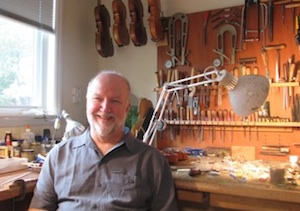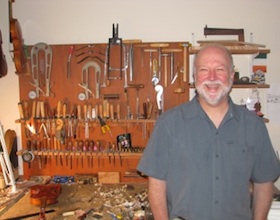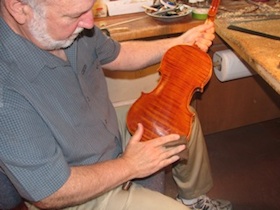
Few things go unchanged for five centuries, but the fine art of violin making is one of them. Ever since Andrea Amati (ca. 1505–ca. 1578) created what is usually considered the first modern violin in his workshop in Cremona, Italy, both the instrument and the way it is produced have stayed pretty much the same.
While factories in low-wage countries like China and India churn out (mostly student) violins by the thousands, even in this industrial setting the instruments still require hand tools and glue and the human touch. But for the connoisseur and the professional, there continue to be craftsmen creating unique violins, alone in their workshops.
Even after living in tech-savvy San Francisco for 17 years, I categorized “violin maker” as an Old World profession. So, recently, when I was doing research for another story, I noticed that local violinist Anthony Martin describes the provenance of his instrument as: Thomas Oliver Croen, Walnut Creek, California, 2005 (after Francesco Gobetti, Venice, Italy, 1717). I was doubly surprised. Not only was there a maker of violins in the Bay Area, but he also made Baroque violins.
The Basics
Apart from the lighting and the presence of a computer, a stereo, and some other modern electronics, Tom Croen’s workshop doesn’t look all that different from historic images, for instance on the website of the Violin Making Museum in Mittenwald, Germany.
Croen’s education is actually directly linked to this Bavarian town; the violin-making school he attended in the U.S. is modeled on the school in Mittenwald, which was founded in 1858 but has a tradition that goes back to the 17th century. That piece of information led to my third big surprise: The Violin Making School of America (VMSA) is located in … Salt Lake City.
“I was searching for direction in college, and my advisor was a violinist,” says Croen. “In his office was a beautiful old French violin that I admired. He had heard about this school that had just started in Salt Lake City. I had been a woodworker and moved from carpentry to furniture to building instruments out of kits. The school sounded like it might fit me.”
“When you make something new, you have this mythical idea of perfection, but when you do repairs, you cannot make it perfect; you have to go with what the instrument is.” — Thomas Oliver Croen
Just by taking the admission exam, Croen knew that this was the right school for him. “As part of the exam they gave us a pine block of about six by two inches, plus a carpenter’s square and a block plane, and we had to create a rectangular block on all angles. I was completely taken by this little project. It required analysis and strategy and eye–hand coordination. If you knew how to do it, you could have it done in 10 minutes. But if you didn’t know, it could take 10 hours. I understood the concept, and thought: If this is what instrument making is like, this is for me.”
Repairs and Experiments

Croen made his first violins at the school, but that didn’t yet make him a violin maker per se. “When you leave school, you are well-trained in the use of tools and mechanics, but the real learning about instruments comes from doing repair work and understanding what restoration is all about,” says Croen. “An older instrument — and it doesn’t even have to be that old — is all twisted. The forces on a violin are not symmetrical. When you make something new, you have this mythical idea of perfection, but when you do repairs, you cannot make it perfect; you have to go with what the instrument is.”
He launches into a detailed description of all the elements that affect the sound of a violin — basically, everything. But it starts with the choice of wood, its density, uniformity of grain, and shape. “You cannot separate the mechanical from the acoustical,” says Croen. “They may have an inverse relationship. A certain shape may be strong, but may not make a strong sound. You have to apply your knowledge and experience to the ultimate goal of the finished product, which is all about sound, not the woodwork. You are not just making a wooden model, but an acoustic resonator.”

To broaden his knowledge, Croen does a lot of experimenting. “When an instrument comes in that needs a new bridge, I will take the original bridge — assuming it will be discarded anyway — and take the opportunity to recarve part of it and see what the effect is on the sound. It is an opportunity to explore the range of different shapes. When you understand what your changes do, you can apply that [knowledge] to your repairs. When an instrument is too bright, you cannot just carve a generic bridge; you must compensate for the things an instrument cannot do on its own.”
Tom Croen puts himself at the service of the artist. “Players have this ‘thing’ in their hand that is their voice, their way of expressing themselves. If they feel that they cannot express themselves properly, it is my job to listen to them and to the violin, help them figure things out. I take all kinds of physical and acoustic measurements and translate all that into something that I can do to improve the instrument. It is a collaboration, in many ways.”
“[Tom] has cared for all my instruments with the same skill, dedication, honesty, and lack of pretense that he brings to making his own,” says Philharmonia Baroque violinist Anthony Martin, via e-mail. He is the proud owner of the baroque violin that triggered this story, and also two other instruments bearing the maker’s mark Thomas Oliver Croen: a viola, and a Guarneri-model violin, “which have been sources of joy and pride ever since I got them,” says Martin.
He remembers: “I was taking my instruments to Tom for repairs and adjustments. I already had heard from two distinguished violinists, David Abel and Jaap Schroeder, that they had obtained exceptional instruments from him. One morning he casually mentioned that he had just finished a violin to be sent the next day to an avocado farmer in Los Osos. I played just a few notes on it before impulsively placing an order. I value him not just as a fine craftsman, but as a trusted friend.”
Sound Achievements
Croen, who was born in 1956, produces an average of four instruments per year. “Violins and violas, mainly; I have made three cellos. Maybe I could make eight instruments per year, but I do a fair amount of repairs. As I get older, I believe that the value of repair is so much about keeping the mind sharp. It is not just about technical skill, but about keeping in touch with sound and acoustics.
“You cannot separate the mechanical from the acoustical.”
“There was a period of about 10 years where I only did commissions. Then 9/11 happened and things changed, but I had already been feeling that commissions were locking me in to making the same things. I wanted to have more flexibility. Not having commissions is financially less secure, but it gives me the freedom to make things that I want to make. That Baroque violin, for example: I am not sure if I would have taken the extra time to make a Baroque instrument. If I just had deadlines for regular violins, it would have been harder.”
Creating a Baroque instrument took study, and Croen also consulted fellow violin makers with experience in building Baroque instruments. “I looked at a lot of Baroque instruments in the past but found the expertise of people who work on them more valuable. Everybody is willing to share; when you give a little, you get more back. That is the nice thing about the violin community. It is not just a field of colleagues and associates; we have become friends.”
“Everybody is willing to share; when you give a little, you get more back. That is the nice thing about the violin community.”
For inspiration about the design of his first Baroque violin, Croen turned to his colleagues from the 17th century. “I had a particular interest in a Venetian maker at that time. He was not of the Amati school but emulated some of the aspects of early Amati instruments that I liked. So that was the form I used. These early violin makers made some of the most sophisticated machines of their day. It is a machine, made out of wood, but it has a function. Technically speaking, the pegs are the only moving part, but it has a job to do; it has to perform.”

